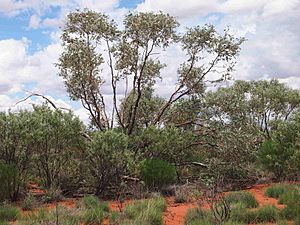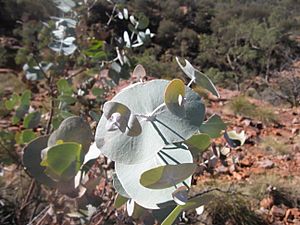Warilu facts for kids
Quick facts for kids Warilu |
|
|---|---|
 |
|
| Eucalyptus gamophylla habit | |
| Scientific classification | |
| Genus: |
Eucalyptus
|
| Species: |
gamophylla
|
The Eucalyptus gamophylla is a special plant known by many names. People often call it warilu, blue-leaved mallee, or twin-leaf mallee. It is a type of mallee, which means it's a shrub or small tree with many stems growing from the ground. This plant naturally grows in Western Australia, South Australia, and the Northern Territory.
Warilu trees usually have smooth bark. Most of their leaves are young leaves that grow in pairs. Their flower buds grow in groups of three and produce whitish flowers. The fruit looks like a cylinder or barrel and has four flat sides.
Contents
What Does the Warilu Plant Look Like?
The Warilu plant is a type of mallee. It usually grows to be about 1.5 to 7 meters (5 to 23 feet) tall. This plant has a special woody swelling at its base called a lignotuber. This helps it regrow after fires. Sometimes, it can even grow very low to the ground, almost like a creeping plant.
Bark and Leaves
The bark of the Warilu is usually smooth. It can be white, cream, or brown. The bark often peels off in short strips. Sometimes, the bottom part of the trunk has rough, stringy bark.
Most of the leaves on a Warilu plant are young leaves. They are attached directly to the stem without a stalk. These leaves grow in opposite pairs. Sometimes, the bases of the leaves even join together! They have a bluish-grey color, which is called glaucous. These leaves are shaped like an egg or a heart. They are about 3.5 to 10 centimeters (1.4 to 3.9 inches) long and 2 to 6 centimeters (0.8 to 2.4 inches) wide.
If the plant has older, "adult" leaves, they also grow in opposite pairs. They are a dull, grayish-green color on both sides. These leaves are about 4 to 10 centimeters (1.6 to 3.9 inches) long and 0.9 to 2 centimeters (0.4 to 0.8 inches) wide. They have a very short leaf stalk, called a petiole, which is only 1 to 6 millimeters long.
Flowers and Fruit
The Warilu's flower buds grow in groups of three. Each group is on a short stalk called a peduncle, which is about 5 to 10 millimeters long. Each individual bud has its own tiny stalk, called a pedicel, about 1 to 3 millimeters long.
When the buds are ready, they look like clubs or pears. They are about 4 to 7 millimeters long and 3 to 4 millimeters wide. The top part of the bud, which covers the flower, is rounded. This cap is called an operculum.
Warilu plants can flower in most months of the year. When they flower often depends on where they grow. In some places, they flower after it rains. The flowers are whitish. After flowering, the plant produces a woody fruit. This fruit is a capsule that can be shaped like a cone, cylinder, bell, or barrel. It has four distinct sides. These fruits are about 5 to 14 millimeters long and 5 to 8 millimeters wide.
Where Does Warilu Grow?
The Warilu plant grows in sandy areas, like sandplains and sand dunes. It also thrives in rocky areas where a spiky grass called spinifex grows.
You can find Warilu plants across a large part of Australia. They grow in the central parts of Western Australia, including the Mid West, Pilbara, and Goldfields-Esperance regions. From there, their range extends east into the central and southern parts of the Northern Territory. You can also find them in the far north of South Australia.
Warilu often grows alongside other plants. Some common plants found with E. gamophylla include Triodia basedowii (a type of spinifex), Acacia ligulata, Acacia georginae, Eremophila longifolia, and Eragrostis eriopoda.
How Can You Grow Warilu?
Eucalyptus gamophylla is a tough plant that is good for gardens. It can handle dry conditions, which means it is drought tolerant. It is also strong in cold weather. It can survive temperatures as low as -12 to -9 degrees Celsius (10 to 15 degrees Fahrenheit). It can also handle frost.
If you plant Warilu in your garden, it will attract birds. It grows quickly and doesn't need much care. Its leaves have a nice smell and can be used in flower arrangements.



